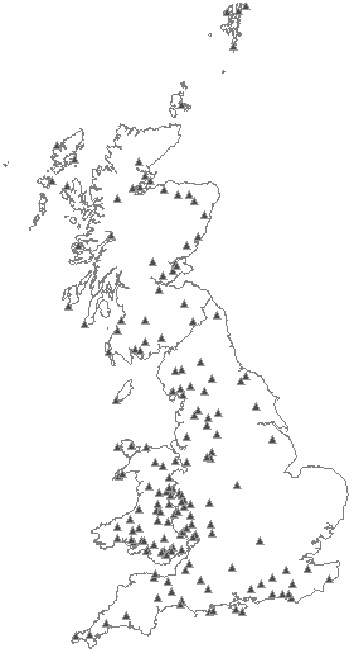
Assuming that you lack Rob Woodall or Brent Lynam's talent for off-road driving, how much walking on the flat and climbing is needed for a round of the Marilyns? The average height of a British Marilyn is 615m above sea level; not a big surprise in Scotland, but more so in the flatlands. But clearly many Marilyns are in groups, or can be started from parking spots on high passes. The overall average climb cannot be that great, but it turns out there are only 162 that in my estimation can be bagged for less than the defining 150 metres.
I set out to calculate the totals by estimating and recording the walk-in and climb for every hill on the list over two years' worth of 'spare moments'. Where the hills were in a group, I also recorded the statistics for either getting back to the start or for walking out to a different end point, if they didn't form a natural circuit. Each hill in a group was assigned the average climb and walk-in for the group up to the last summit, and the walk out was assigned to the group. I organised it this way as a quick indicator of different day lengths I could choose in an area according to conditions, relative fitness and energy levels. Since I descend about three times faster than I climb, and I'm much faster on the flat than either, it is the getting there that defines the length of my hill day, so I put more effort into estimating the climb (by counting contours) than the distance (by counting grid squares).
My routes will differ from yours (one real joy of the Marilyns), so questions about the hill with the largest walk-in or climb will remain subjective. I have assumed that no boats will be used, nor air transport. I have also assumed that there will be no remote camping or bothying, so in reality some remoter hills could require less effort than I have reckoned. For the record, the individual hill with the greatest climb using my way of reckoning is Ladhar Bheinn (10B), while that with the longest walk-in is Sgurr nan Ceathreamhnan (11A).
Some interesting statistics emerged along the way. About two- thirds of the list would most likely be tackled as singletons, with the remaining third forming natural groups. About 300 Marilyns have vehicle tracks to the summit, and a similar number have trees; some pleasant woodland, others blanket forest like the east face of Crock. About 100 involve some modest rock scrambling, and a few (like Stac Lee) are impossible for this mere mortal. En route to the overall answer, I wondered which sub-list would involve more climbing and walk in, Corbetts or Grahams? It is the Corbetts (as you were probably expecting), but the margin is only 20km of climbing and 100km of walk-in. Welsh Marilyn connoisseurs may also be surprised by the comparison with England's Marilyns, where the total climb is nearly identical, but there is less walking on the flat in Wales, mainly due to a slightly lower number of hills.
The average climb per hill, from either a roadside start or from the nearest Marilyn, turns out to be just over 400m, at a gradient of just over 10%. Hall of Fame entry needs at least 112km of climbing (barely more than a Graham round), or 1000km of walk-in (less than a Graham round) based on routes using the least climb and shortest walk-in possible.
And my final answer? A full Marilyn round, using car and ferry (with two Shetland outlier flights) involves about 11300km of flat walking (there and back for singletons or as explained above for groups) and 620km of vertical climbing. Oh, and about 30 years' worth of leisure time.
| Climb | Walk-in | Climb per hill | Walk-in per hill | |
| Marilyn Munros | 140km | 1259km | 683m | 6.14km |
| Corbetts | 128km | 1200km | 584m | 5.48km |
| Grahams | 108km | 1100km | 484m | 4.93km |
| Welsh Marilyns | 39km | 335km | 252m | 2.16km |
| English Marilyns | 39.5km | 396km | 222m | 2.22km |
| Minimum climb to HoF | 112.7km | 1274km | 188m | 2.12km |
| Minimum walk-in to HoF | 147.4km | 981km | 246m | 1.64km |

The distribution of the 162 sub-150m climb Marilyns